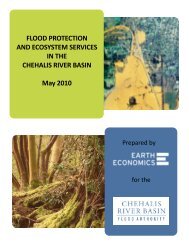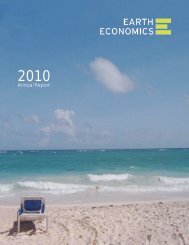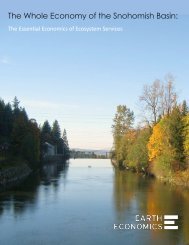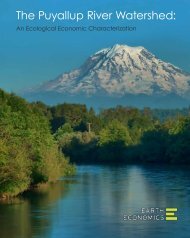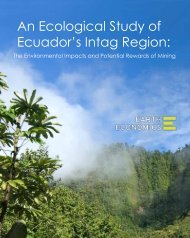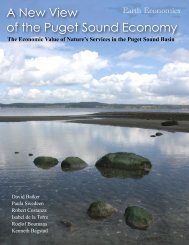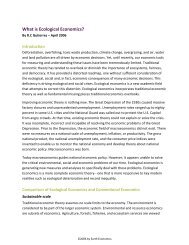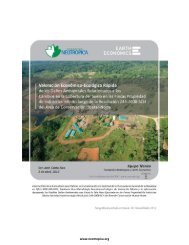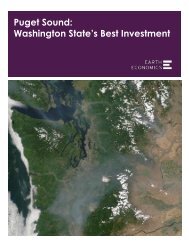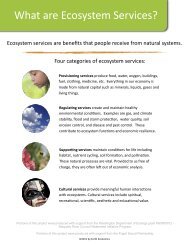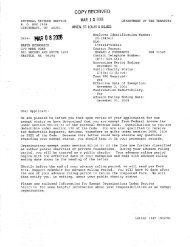The Spot Prawn Fishery: A Status Report - Earth Economics
The Spot Prawn Fishery: A Status Report - Earth Economics
The Spot Prawn Fishery: A Status Report - Earth Economics
You also want an ePaper? Increase the reach of your titles
YUMPU automatically turns print PDFs into web optimized ePapers that Google loves.
<strong>The</strong> <strong>Spot</strong> <strong>Prawn</strong> <strong>Fishery</strong>: A <strong>Status</strong> <strong>Report</strong><br />
<strong>The</strong> 1999–2000 spot prawn fishery was characterized<br />
by:<br />
•a strong market for whole prawns with an<br />
approximate value of $4 million<br />
•a growing number of catcher-processors<br />
participating<br />
•an increasing number of permits fished<br />
•an increase in total pounds caught per permit<br />
•an increase in pounds per landing<br />
•a majority of fishing districts being harvested<br />
within one month<br />
Today’s management and conservation concerns<br />
fall into two broad categories: the potential for<br />
overfishing and the potential for overcapitalization.<br />
<strong>The</strong> risk of overfishing stems from the following<br />
factors:<br />
•GHLs are not based on current estimates of<br />
population abundance<br />
•size-specific harvesting; i.e., the retention of<br />
the larger, more valuable (in both economic and<br />
biological terms) females<br />
•potential for serial stock depletion<br />
<strong>The</strong> potential for overcapitalization of the fishery<br />
arises from the following factors:<br />
•increasing number of permits actively fished<br />
•increasing number of catcher-processors<br />
participating in the fishery<br />
•increasing intensity and efficiency of the fishery<br />
<strong>The</strong> Shrimp Trawl <strong>Fishery</strong><br />
Annual shrimp trawl harvests have fallen steadily;<br />
prime fishing areas (Cook Inlet, Kodiak, and the<br />
Alaska Peninsula) are now closed due to depleted<br />
stocks. Pink shrimp are still the primary target of<br />
the trawl fishery (otter trawls are banned in southeastern<br />
Alaska), constituting approximately 80%<br />
of trawl landings by weight.<br />
<strong>Spot</strong> prawns are landed only incidentally in<br />
Alaska’s shrimp trawl fisheries. Comparatively<br />
few adult spot prawns are harvested by trawl gear,<br />
as the beam trawlers do not fish the rocky habitats<br />
preferred by adult spot prawns. Smaller spot<br />
prawns (juveniles), which can be found in softbottom<br />
habitats, are occasionally caught in beam<br />
trawls (Love, ADFG. Pers. comm., May 2001).<br />
Approximately 1,029,382 kg. (2,264,641 pounds)<br />
of shrimp were landed in the 1998–99 fishing season.<br />
It is estimated that the harvest was made up<br />
of “only a trace of spot prawns” (Koeneman and<br />
Botelho 2000b). Through November 1999 of the<br />
1999–2000 fishing season, 829,183 kg. (1,824,203<br />
pounds) of shrimp had been landed—2,409 kg.<br />
(5,300 pounds) was spot prawns.<br />
Recreational, Subsistence, and Personal Use<br />
<strong>Spot</strong> <strong>Prawn</strong> Fisheries<br />
<strong>The</strong> recreational, subsistence, and personal use<br />
fisheries, specifically for spot prawns, are regulated<br />
but not closely monitored in Southeastern<br />
Estimated Recreational/Personal Use Harvests of Shrimp in Gallons in Southern<br />
Alaska as Estimated from the Statewide Harvest Mail Survey, 1992–1999<br />
Source: Paul Suchanek, ADFG<br />
10



